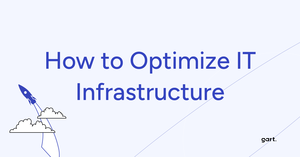How to Optimize IT Infrastructure
Publicado por nastya zelenovska
Cuerpo
In today's fast-paced digital world, optimizing IT infrastructure is essential for businesses to remain competitive, secure, and efficient. Proper optimization can lead to cost savings, improved performance, enhanced security, and greater agility. This article outlines key strategies and best practices for optimizing your IT infrastructure.
1. Assess Current Infrastructure
The first step in optimizing your IT infrastructure is to conduct a comprehensive assessment. This includes:
- Inventory Management: Keep a detailed inventory of all hardware, software, and network components.
- Performance Monitoring: Use tools to monitor the performance of servers, storage, network devices, and applications.
- Utilization Analysis: Evaluate the utilization rates of your resources to identify underused or overburdened components.
2. Embrace Cloud Computing
Cloud computing offers flexibility, scalability, and cost efficiency. Consider the following:
- Hybrid Cloud Solutions: Combine on-premises infrastructure with cloud services to leverage the benefits of both.
- Cloud Migration: Identify which workloads and applications can be moved to the cloud to reduce on-premises resource demand.
- Cloud Optimization Tools: Use cloud management platforms to monitor and optimize cloud resource usage.
3. Implement Virtualization
Virtualization allows you to run multiple virtual machines on a single physical server, optimizing resource use:
- Server Virtualization: Consolidate servers to reduce hardware costs and improve efficiency.
- Storage Virtualization: Pool storage resources to simplify management and increase utilization.
- Network Virtualization: Create virtual networks to enhance flexibility and scalability.
4. Automate and Orchestrate
Automation and orchestration can significantly enhance IT efficiency:
- Automated Provisioning: Use automation tools to provision resources quickly and accurately.
- Configuration Management: Automate configuration management to ensure consistency and reduce human error.
- Orchestration: Implement orchestration tools to manage complex workflows and processes across multiple systems.
5. Enhance Security
A secure IT infrastructure is critical. Consider these measures:
- Regular Audits: Conduct regular security audits and vulnerability assessments.
- Patch Management: Implement automated patch management to ensure all systems are up-to-date.
- Security Best Practices: Follow industry best practices for securing hardware, software, and network components.
6. Optimize Network Performance
Efficient network performance is crucial for overall IT infrastructure optimization:
- Network Monitoring: Use network monitoring tools to identify and resolve bottlenecks.
- Bandwidth Management: Implement bandwidth management techniques to prioritize critical traffic.
- Network Design: Regularly review and update network design to accommodate changing demands and technologies.
7. Implement Disaster Recovery and Backup Solutions
Robust disaster recovery and backup solutions are essential for minimizing downtime and data loss:
- Backup Solutions: Implement reliable backup solutions to protect critical data.
- Disaster Recovery Plans: Develop and regularly test disaster recovery plans to ensure quick recovery from disruptions.
- Redundancy: Build redundancy into your infrastructure to eliminate single points of failure.
8. Train and Develop Staff
Well-trained staff are crucial for maintaining an optimized IT infrastructure:
- Ongoing Training: Provide regular training on the latest technologies and best practices.
- Certifications: Encourage staff to obtain relevant certifications to enhance their skills.
- Knowledge Sharing: Foster a culture of knowledge sharing and collaboration among IT teams.
9. Regularly Review and Update Policies
IT policies should evolve with your business needs and technological advancements:
- Policy Reviews: Regularly review IT policies to ensure they are up-to-date and effective.
- Compliance: Ensure policies comply with industry standards and regulations.
- User Policies: Update user policies to reflect new security measures and usage guidelines.
10. Measure and Optimize Continuously
Optimization is an ongoing process:
- Key Performance Indicators (KPIs): Define and monitor KPIs to measure the effectiveness of your optimization efforts.
- Continuous Improvement: Foster a culture of continuous improvement by regularly assessing and refining your IT infrastructure.
- Feedback Loop: Establish a feedback loop to gather insights from users and stakeholders for ongoing enhancements.
Conclusion
Optimizing IT infrastructure is an ongoing process that requires a strategic approach and a commitment to continuous improvement. By assessing your current setup, leveraging cloud and virtualization technologies, automating processes, enhancing security, and investing in training, you can create a robust, efficient, and future-proof IT infrastructure that drives business success.
1. Assess Current Infrastructure
The first step in optimizing your IT infrastructure is to conduct a comprehensive assessment. This includes:
- Inventory Management: Keep a detailed inventory of all hardware, software, and network components.
- Performance Monitoring: Use tools to monitor the performance of servers, storage, network devices, and applications.
- Utilization Analysis: Evaluate the utilization rates of your resources to identify underused or overburdened components.
2. Embrace Cloud Computing
Cloud computing offers flexibility, scalability, and cost efficiency. Consider the following:
- Hybrid Cloud Solutions: Combine on-premises infrastructure with cloud services to leverage the benefits of both.
- Cloud Migration: Identify which workloads and applications can be moved to the cloud to reduce on-premises resource demand.
- Cloud Optimization Tools: Use cloud management platforms to monitor and optimize cloud resource usage.
3. Implement Virtualization
Virtualization allows you to run multiple virtual machines on a single physical server, optimizing resource use:
- Server Virtualization: Consolidate servers to reduce hardware costs and improve efficiency.
- Storage Virtualization: Pool storage resources to simplify management and increase utilization.
- Network Virtualization: Create virtual networks to enhance flexibility and scalability.
4. Automate and Orchestrate
Automation and orchestration can significantly enhance IT efficiency:
- Automated Provisioning: Use automation tools to provision resources quickly and accurately.
- Configuration Management: Automate configuration management to ensure consistency and reduce human error.
- Orchestration: Implement orchestration tools to manage complex workflows and processes across multiple systems.
5. Enhance Security
A secure IT infrastructure is critical. Consider these measures:
- Regular Audits: Conduct regular security audits and vulnerability assessments.
- Patch Management: Implement automated patch management to ensure all systems are up-to-date.
- Security Best Practices: Follow industry best practices for securing hardware, software, and network components.
6. Optimize Network Performance
Efficient network performance is crucial for overall IT infrastructure optimization:
- Network Monitoring: Use network monitoring tools to identify and resolve bottlenecks.
- Bandwidth Management: Implement bandwidth management techniques to prioritize critical traffic.
- Network Design: Regularly review and update network design to accommodate changing demands and technologies.
7. Implement Disaster Recovery and Backup Solutions
Robust disaster recovery and backup solutions are essential for minimizing downtime and data loss:
- Backup Solutions: Implement reliable backup solutions to protect critical data.
- Disaster Recovery Plans: Develop and regularly test disaster recovery plans to ensure quick recovery from disruptions.
- Redundancy: Build redundancy into your infrastructure to eliminate single points of failure.
8. Train and Develop Staff
Well-trained staff are crucial for maintaining an optimized IT infrastructure:
- Ongoing Training: Provide regular training on the latest technologies and best practices.
- Certifications: Encourage staff to obtain relevant certifications to enhance their skills.
- Knowledge Sharing: Foster a culture of knowledge sharing and collaboration among IT teams.
9. Regularly Review and Update Policies
IT policies should evolve with your business needs and technological advancements:
- Policy Reviews: Regularly review IT policies to ensure they are up-to-date and effective.
- Compliance: Ensure policies comply with industry standards and regulations.
- User Policies: Update user policies to reflect new security measures and usage guidelines.
10. Measure and Optimize Continuously
Optimization is an ongoing process:
- Key Performance Indicators (KPIs): Define and monitor KPIs to measure the effectiveness of your optimization efforts.
- Continuous Improvement: Foster a culture of continuous improvement by regularly assessing and refining your IT infrastructure.
- Feedback Loop: Establish a feedback loop to gather insights from users and stakeholders for ongoing enhancements.
Conclusion
Optimizing IT infrastructure is an ongoing process that requires a strategic approach and a commitment to continuous improvement. By assessing your current setup, leveraging cloud and virtualization technologies, automating processes, enhancing security, and investing in training, you can create a robust, efficient, and future-proof IT infrastructure that drives business success.










Comentarios